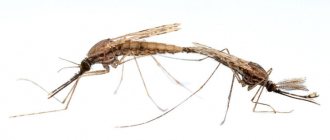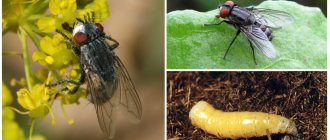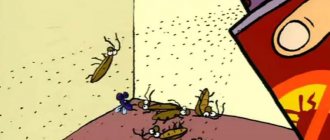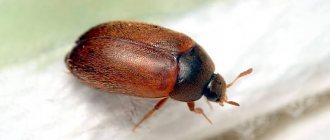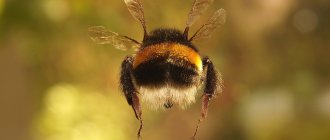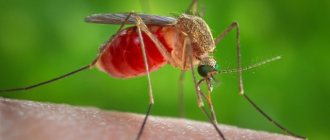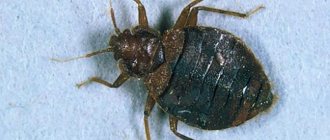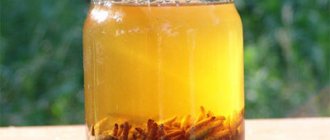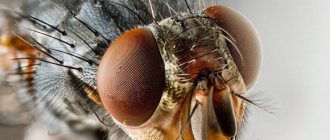How many insects are there on Earth?
The number of insect species is so great that no other class of animals can even come close to it in number. Number of insects in 1 square. m of moistened soil ranges from 1000 to 2000, and many insects are even indistinguishable to the human eye.
Many insects and their larvae are successfully used in fishing, serving as bait. Such insects include caddis flies, bloodworms, mayflies, dragonflies, stoneflies and caterpillars of other different types of butterflies, bark beetles, chafers, maggots and many others. The larva is one of the phases of the insect's life cycle.
List of larvae with independent names
- The axolotl
is a neotenic larva of Ambystoma (tailed amphibians). - Actinotroch
is a phoronid larva. - Auricularia
is the early phase of development of holothurian larvae. - Bipinnaria
is the early phase of sea star larval development. - Brachiolaria
is the late developmental stage of a starfish larva. - Veliger
is a larva of gastropods and bivalves. - Glaucotoe
is a crawling crustacean larva. - Glochidium
is a larva of bivalves. - A tadpole
is the larva of a tailless amphibian. - The caterpillar
is the larva of butterflies. - Dipleurula (dipleurula)
is an early larval form common to echinoderms and coelenterates, which later transforms in different groups into auricularia, bipinnaria, pluteus or tornaria. - Doliolaria
is the middle phase of development of holothurian larvae. - Zoea
is an early larva of a decapod crustacean. - Coracidium
is a larva of a wide tapeworm, covered with cilia and equipped with six hooks. - The coretra
is a mosquito larva from the family Chaoboridae. - The rat
is the larva of some hover flies (Diptera: Syrphidae). - Leptocephalus
is a larva (fry) of an eel and other eel-like fish. - Lycophora
is a cestode larva. - The false caterpillar
is the larva of sawflies (Hymenoptera-Symphyta). - The false wireworm
is a larva of beetles of the darkling beetle and pollen beetle families. - Megalopa
is a late larva of decapod crustaceans. - Metanauplius
is the larval stage of many crustacean species, following the nauplius. - Metatrochophore
is a larva of polychaete annelids that develops from a trochophore and turns into a nectochaete. - Mysis
is a late larva of long-tailed decapod crustaceans (Decapoda-Macrura). - Miracidium
is a sporocyst larva of flukes (Trematoda). - The bloodworm
is the larva of bell mosquitoes (Diptera: Chironomidae). - Müllerian larva
is the larva of ciliated polyclada worms (Polyclada) - Nauplius
is the early phase of larval development, characteristic of many crustaceans. - Naiad
is the larva of dragonflies. - Nektochaete
is a late larva of polychaete annelids that develops from a metatrochophore. - Nymph
is the traditional name for the larval stage of development of some arthropods with incomplete metamorphosis (mites and a number of groups of insects). - Oncomiracidium
is the larva of monogenea (monogenetic flukes). - Oncosphere
, or
six-hooked larva
, is the larva of tapeworms (Cestoda). - Maggot
is the larva of round stitch flies. - Parenchymula
is the larva of sponges. - The pentacle
is the late developmental phase of holothurian larvae. - Sandwort
is a lamprey larva. - Pilidium
is a nemertean larva. - Planktosphere
is the larva of a gastrointestinal worm. - Planula
is a coelenterate larva. - Pluteus
, or
pluteus
, is an echinoderm larva.
For the larvae of brittle stars and sea urchins, special terms are used: Ophiopluteus
, or
ophiopluteus
- larva of brittle stars; - Echinopluteus
, or
Echinopluteus
, is the larva of sea urchins.
is the larva of click beetles.
is a crustacean larva emerging from an egg.
is the larva of sea spiders.
is the larva of the battle mosquito.
is a larva of intestinal breathing.
is the initial phase of larval development in insects with hypermetamorphosis.
is the early larva of trochophore animals (molluscs, polychaete annelids, sipunculids, etc.).
is the non-motile stage of tapeworm development.
is the larva of marita flukes (Trematoda).
is the last larval stage of development of barnacles.
is one of the varieties of the larval stage of development - the fins of some tapeworms. Similar to cysticercoid.
is one of the varieties of the larval stage of development - the fins of some tapeworms.
is a bryozoan larva.
, or
oncosphere
, is the larva of tapeworms (Cestoda).
Dragonfly larvae
Dragonfly larva
Dragonfly larvae are found more often in stagnant bodies of water or weakly flowing ones, less often in rivers. The larvae live deep in the soil and among vegetation. Before turning into a dragonfly, the larvae crawl onto aquatic plants located along the shore of a reservoir.
The larvae of various beetles are called bark beetles. They are found under the bark of old stumps, as well as in wood warehouses or even in destroyed buildings.
Description and features
The two-winged insect with short antennae belongs to the Tachi-nidae family. Large hemispheres of eyes with a multi-colored iridescence on a shaggy body up to 17 mm long, transparent wings of the fly make up the external appearance. The species Dermatobia hominis, which is dangerous to humans, lives in Central America. It is capable of attacking and laying its eggs under the skin.
Many have seen these large flies with bright colors in the countryside, in nature or fishing. Externally, the gadfly in the photo is very similar to the two-winged horsefly; they are often confused with each other. Their habitat is the same. The bite of a horsefly is dictated by hunger; it is a blood-sucking insect. The main difference is nutrition. A gadfly, like a horsefly , can bite, but only for the purpose of reproduction.
In some regions the insect is known as spiderweed. Many species of dipterous flies that parasitize large mammals are collectively called gadflies. Common features for insects:
- gadfly dimensions 15-20 mm;
- the mouth is absent or reduced;
- body with villi;
- huge eyes;
- oval body;
- the front legs are shorter than the hind legs;
- almost transparent mesh wings.
The body color is very different. For northern latitudes it is of calmer tones:
- brown;
- dark gray;
- different shades of blue.
In the south and tropics, the insect closely resembles small bumblebees with orange and black stripes. It is believed that the gadfly's flight speed of 120-140 km/h is comparable to that of a dragonfly.
Kinds
The family Nu-podermatidae includes insects in which the larva develops in the nodules under the skin of animals. They parasitize many mammals. Among them:
- Small rodents. Here development takes a little time. The female lays eggs on the fur. The larvae that emerge from them burrow under the skin. There is no migration.
- Large mammals. After laying on the hair, the larvae that emerge from the eggs begin migrating to the back of the animal. Their path of movement goes along the subcutaneous layer, inside the muscles and internal organs. Travel time is from 3 to 9 months.
There are types of gadflies:
- Gasterophilidae – parasites in the stomachs of animals. Flies of medium or large size (9-20 mm). Adults do not need food. They are found in the eastern hemisphere, but equines are common everywhere. The larvae live inside the stomachs of odd-toed ungulates, elephants, and hippopotamuses. The female gadfly lays about 2 thousand eggs on the skin or hair layer near the mouth. Gasterophilus pecorum lays eggs on the grass. The first instar larvae enter the digestive system and live until they grow. They come out naturally (with excrement). Animals infected with parasites develop gastrointestinal pathology.
- Horse (Gasterophilus intestinalis) is one of the common species. Length varies from 13 to 16 mm. The hairs on the body are yellow or brown. The wings are all with dark spots. A noticeable feature is a bright black dot in the radial vein. The insect uses horses and donkeys for its reproduction. In females, the ovipositor is strongly bent under the body. During flight, females lay on the surface of the skin in places where victims can scratch with their teeth. When the larva enters the mouth, it develops for about a month, then passes through the pharynx into the stomach. Their number sometimes reaches hundreds.
- Northern deer (Oedemagena taran-di) - lives off reindeer. Animals travel great distances to winter. There the insects grow, leave the host and move into the ground. With the onset of spring, deer migrate north. Young gadflies must fly many kilometers to again parasitize animals. Natural instinct drives the insects north, they reach the victims and begin to attack defenseless deer. One female can lay up to 650 eggs.
All gadflies are divided according to the type of mouth opening. In Oestridae typicae it is absent or underdeveloped. Representatives of the small Cuterebridae group have a more pronounced proboscis (mouth), without tentacles. Scientists divide the first type into three sections:
- Gastricolae - larvae with two hooks for penetration; there are special tubercles with small spines;
- Cavicolae – two hooks and large spines, the female is viviparous, no ovipositor;
- Cuticolae - there are no hooks, the spines are small, they are almost invisible.
Cattle attack Hypoderma bovis De G. bovine botfly . For horses and donkeys, the equine species has become a threat. Sheep try to escape from the sheep type Oestrus ovis L. Even wild animals have their own varieties:
- American squirrels are attacked by C. emasculator Fitch;
- Elephant intestines are infested with Cobboldia elephantis Brau;
- rhino suffers from Gastrophilus Rhinocerontis Ow.
In the tropics of Central America lives Ver macaque and moyocuil, which can accidentally attack a person. After a gadfly bites and the larva implants, a large tumor, or hardening, with a hole at the top grows. This type affects dogs and livestock.
The photo shows a gadfly larva
Types of insect development
In all representatives of this class, the newborn individual differs significantly from adults. This type of development is called indirect. But in different groups of insects it can occur with complete or incomplete transformation. Often the larva and the adult differ not only in appearance, but also in their methods of life. Thus, the butterfly larva feeds on green foliage, and the adult on flower nectar. Insects, which are characterized by incomplete metamorphosis, lead the same lifestyle at all stages of development.
The term transformation itself means the presence of a larval stage in the process of individual development. Only insect ontogenesis can occur in different ways.

